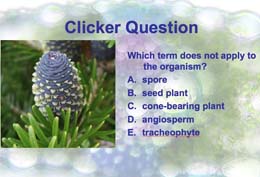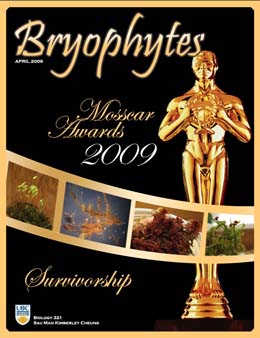Introduction/Background
 I have been teaching in the Botany Department for about 17 years in courses ranging from first year introductory biology to fourth year plant anatomy. I enjoy “lecturing”, lab investigation, and roaming in the bog and forest.
I have been teaching in the Botany Department for about 17 years in courses ranging from first year introductory biology to fourth year plant anatomy. I enjoy “lecturing”, lab investigation, and roaming in the bog and forest.
Teaching Philosophy
My philosophy of teaching is really about learning. Teaching practices should focus on the best methods to facilitate student understanding and motivate inquiry. The scholarship in teaching/learning is an exciting part of being an instructor; keeping up with current developments in education and devising and assessing better ways to help students learn is challenging. If you succeed you can be a good teacher. A good educator has many qualities: a fascination with the subject, a commitment to generating enthusiasm and interest, is organized, challenging, perceives student needs, provides constructive feedback, and is respectful. An excellent teacher does all of these, and something a little extra that results in a positive change (transformation) in the student. This shift could be an ignited interest in a subject or an attitudinal change about science. I want to be a teacher than inspires students and helps them change the way they see biology and their world. To all my courses I bring a genuine enthusiasm for the organisms from their tissues and cells to their roles on our planet. I am equally enthusiastic about sharing these wonders with others and their integration with the dynamics of teaching and learning.
Learning happens best in a safe, supportive, stimulating environment. A positive outlook on course content leads to improved retention and deeper understanding. Most of the learning however, does not happen in the classroom. So what is the purpose of lectures? Their most valuable function is to help students develop a conceptual framework with which to relate information. Students often have their own way of viewing and organizing information that is simple and may or may not be accurate. Lectures provide a forum for us to provide students with more than just the facts. I like to share other elements such as research at UBC, local uses of a particular plant, a current environmental issue, and images that help to put information in context. Making connections helps students learn and construct a framework on which they can build. Relating what they are learning with their own lives is very powerful.
There is lots of emphasis on active learning activities and rightly so. We learn by doing. Students need to be engaged and interacting with information with their full attention. Clickers are excellent tools for such engagement; in addition to active learning, they can be used to initiate discussion, motivate pre-readings, identify misconceptions, improve class attendance, connect ideas, promote reflection, and make students aware of their performance in relation to the entire class. Other effective active learning activities include question/answer, true/false question game, discussions (e.g. think pair share), and writing short answers (e.g. minute paper). They help students consolidate their understanding. Reading from a textbook is generally not considered active learning, but it could be when accompanied with questions, problems, or scenarios.
At the beginning of a course, I define my expectations of the students and what they can expect from me as well as provide a well-developed syllabus. These serve as a course contract, which I stand by. I try to make each lecture’s learning objectives clear and useful; they keep me on track and provide students a knowledge framework (Example of lesson learning objectives – Biol 210). In the introductory lecture I outline the activities so students can decide whether or not they want to take it – Biol 343 Intro Lecture.
I let them know why I am doing an activity, particularly if it is not something they usually encounter in other classes. For example, the minute paper is often an uncomfortable activity for a number of students. I explain the evidence that shows that it improves student learning…and that it is a practice exam question. When I try something new I let them know why I am doing it and that I value their feedback (and I mean it).
 I don’t believe that we need to reduce the amount of content students are responsible for. Knowledge is the foundation from which higher-level learning and critical thinking can occur. I do believe in reducing the amount of new content a student is presented with during a lecture. This means that students should be responsible for some of their own learning outside of lecture. This can be done by pre-reading plus assessment such as a quiz for motivation, project research, etc. There are some lessons in which the content is challenging for students. For example, the Biology 343 (Plants and People) class is made up of science and arts students so the background knowledge is varied. One strategy I use is the work along handout for complicated topics such as plant structure and reproduction. Students annotate worksheets as we progress through the lecture (Biol 343 work along hand-out on Angiosperm Reproduction). There is also a lab that accompanies these lectures to reinforce the learning.
I don’t believe that we need to reduce the amount of content students are responsible for. Knowledge is the foundation from which higher-level learning and critical thinking can occur. I do believe in reducing the amount of new content a student is presented with during a lecture. This means that students should be responsible for some of their own learning outside of lecture. This can be done by pre-reading plus assessment such as a quiz for motivation, project research, etc. There are some lessons in which the content is challenging for students. For example, the Biology 343 (Plants and People) class is made up of science and arts students so the background knowledge is varied. One strategy I use is the work along handout for complicated topics such as plant structure and reproduction. Students annotate worksheets as we progress through the lecture (Biol 343 work along hand-out on Angiosperm Reproduction). There is also a lab that accompanies these lectures to reinforce the learning.
Assessments should be frequent and support learning objectives. Frequent assessment not only reinforces the content throughout the term, but also helps students accumulate a body of knowledge, gain deeper understanding, and provides the opportunity for self-assessment. The teacher can gauge how well students understand course material and they can address misconceptions. Assessment restricted to midterm and end-of-term often fosters short-term learning. Self- or peer-assessment has many additional benefits including the development of critical reasoning and writing skills. Assessments of other types of activities are also important even if only worth a few marks.
 The value of labs and fieldtrips cannot be over stated. They are opportunities for students to interact with course content in a different way from lecture (promote long-term learning and deeper understanding as well as addressing some of the complex issues of sustainability). These small group settings are also good for assessing a student’s level of knowledge. In the first week of Biology 321, and 343 the classes go on a fieldtrip. The associated assignment helps me gauge their level of knowledge and I can address any gaps. As the term progresses fieldtrips build on course knowledge so by the end of the course students can “do science” in an authentic way through term-long projects and field studies where they collect and analyse data. They make discoveries and can even publish on the course website. Student projects are valuable learning opportunities as well as giving them an opportunity to pursue areas they find interesting and develop communication skills.
The value of labs and fieldtrips cannot be over stated. They are opportunities for students to interact with course content in a different way from lecture (promote long-term learning and deeper understanding as well as addressing some of the complex issues of sustainability). These small group settings are also good for assessing a student’s level of knowledge. In the first week of Biology 321, and 343 the classes go on a fieldtrip. The associated assignment helps me gauge their level of knowledge and I can address any gaps. As the term progresses fieldtrips build on course knowledge so by the end of the course students can “do science” in an authentic way through term-long projects and field studies where they collect and analyse data. They make discoveries and can even publish on the course website. Student projects are valuable learning opportunities as well as giving them an opportunity to pursue areas they find interesting and develop communication skills.
Part of our responsibilities as educators is to help students develop skills in listening, reading, communication, problem solving and critical thinking. We want our graduates to be prepared for careers or continued study. Varied course activities such as discussion, written and oral presentations as well as working through problems and concepts independently and in groups (such as project work) prepare students for postgraduate engagement. Collaborative activities provide a forum for applying what is being learned as well as sharing different perspectives. In addition, I believe creativity and authorship (publishing) encourage a student’s identity as a scientist. Moreover, the refinement of observational skills is fundamental to scientific inquiry; appreciation for and understanding of organisms are generated through hands-on experience with living specimens in lecture, lab, and on fieldtrips. With varied activities students think in different contexts about concepts and thus have a better understanding (reflective learning). One of our main responsibilities as educators is to provide students the tools and skills they need to not only be good global citizens, but also to be equipped to make positive changes to our world. Sustainability education is about making students aware of issues (and their complexity) that affect the health of the planet and humanity. It is easy to relay examples of doom and gloom that surround us, but we also need to help develop attitudes and abilities to move forward for positive change. Engagement in community projects provides students with local context and sense of place.
I take interest in my students’ academic growth, often giving advice based on my experiences as a student, advisor, scientist, and educator. All of our students are capable of success, but many need guidance and motivation to reach closer to their potential. Through advising, presenting study skill workshops, and by example, I try to help students reach their goals in academics, career planning, and as good global citizens.



